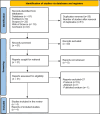Evaluating the efficacy and safety of survodutide for obesity: a systematic review and meta-analysis of randomized controlled trials
- PMID: 40557198
- PMCID: PMC12184113
- DOI: 10.1080/08998280.2025.2480512
Evaluating the efficacy and safety of survodutide for obesity: a systematic review and meta-analysis of randomized controlled trials
Abstract
Background: Glucagon-like peptide-1 (GLP-1) agonists have established their efficacy and safety in the treatment of obesity. In this study, we aimed to assess the efficacy and safety of survodutide, a new GLP-1 agonist.
Methods: We searched PubMed, Web of Science, Scopus, and Cochrane Library databases until May 2024 for randomized controlled trials using survodutide obesity treatment. Continuous data were pooled as standardized mean difference (SMD), while dichotomous data were pooled as risk ratios (RR) with 95% confidence intervals.
Results: There was a significant relative body weight reduction in the survodutide group (SMD: -1.5; 95% CI: -2.05 to -0.95; P < 0.00001). Overall adverse events in the four included studies weren't significantly different between the survodutide group and placebo group (RR: 1.18; 95% CI: 0.98 to 1.41; I 2 = 72%; P = 0.08). Survodutide was associated with a higher risk of developing diarrhea than the placebo group in the four included trials (RR: 1.89; 95% CI: 1.2 to 2.97; I 2=0%; P < 0.00001).
Conclusion: Survodutide effectively reduced relative body weight, absolute body weight, and hemoglobin A1c (P < 0.00001). The incidence of adverse events was comparable between the two groups, while gastrointestinal adverse events were higher in the survodutide group.
Keywords: Meta-analysis; obesity; review; survodutide.
Copyright © 2025 Baylor University Medical Center.
Conflict of interest statement
The authors report no funding or conflicts of interest.
Figures




Similar articles
-
Systemic pharmacological treatments for chronic plaque psoriasis: a network meta-analysis.Cochrane Database Syst Rev. 2017 Dec 22;12(12):CD011535. doi: 10.1002/14651858.CD011535.pub2. Cochrane Database Syst Rev. 2017. Update in: Cochrane Database Syst Rev. 2020 Jan 9;1:CD011535. doi: 10.1002/14651858.CD011535.pub3. PMID: 29271481 Free PMC article. Updated.
-
Systemic pharmacological treatments for chronic plaque psoriasis: a network meta-analysis.Cochrane Database Syst Rev. 2021 Apr 19;4(4):CD011535. doi: 10.1002/14651858.CD011535.pub4. Cochrane Database Syst Rev. 2021. Update in: Cochrane Database Syst Rev. 2022 May 23;5:CD011535. doi: 10.1002/14651858.CD011535.pub5. PMID: 33871055 Free PMC article. Updated.
-
Electronic cigarettes for smoking cessation.Cochrane Database Syst Rev. 2022 Nov 17;11(11):CD010216. doi: 10.1002/14651858.CD010216.pub7. Cochrane Database Syst Rev. 2022. Update in: Cochrane Database Syst Rev. 2024 Jan 8;1:CD010216. doi: 10.1002/14651858.CD010216.pub8. PMID: 36384212 Free PMC article. Updated.
-
Antidepressants for depression in adults with HIV infection.Cochrane Database Syst Rev. 2018 Jan 22;1(1):CD008525. doi: 10.1002/14651858.CD008525.pub3. Cochrane Database Syst Rev. 2018. PMID: 29355886 Free PMC article.
-
Electronic cigarettes for smoking cessation.Cochrane Database Syst Rev. 2021 Sep 14;9(9):CD010216. doi: 10.1002/14651858.CD010216.pub6. Cochrane Database Syst Rev. 2021. Update in: Cochrane Database Syst Rev. 2022 Nov 17;11:CD010216. doi: 10.1002/14651858.CD010216.pub7. PMID: 34519354 Free PMC article. Updated.
References
LinkOut - more resources
Full Text Sources
